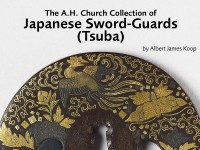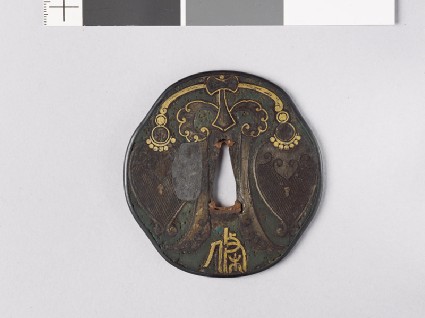The A. H. Church Collection of Japanese Sword-Guards (Tsuba)
An unpublished catalogue of the A. H. Church collection of Japanese sword-guards (tsuba) by Albert James Koop.

Publications online: 1264 objects
Octagonal tsuba with Chinese pendent
-
Literature notes
Rounded octagonal; on the front a flat raised symmetrical design of a Chinese pendent ornament with two large ovoid drops, covered with gold or silver wire nunome, and, in base, a seal-character [[Japanese text] JŌ, koyeda, "twig", also "item", "district"] (gilt); ground filled in with dark green enamel, much decayed; the back covered with a diagonal checker in silver wire nunome; modern shakudō rim; shapeless kodzuka-hole plugged with lead (recent). Nagasaki work. -
Details
- Associated place
- Date
- 17th century (1601 - 1700)
- Material and technique
- obverse and reverse: iron; shakudō rim; kozuka-hole plugged with lead; tang-hole plugged with soft metal, probably copper obverse: with gold or silver wire nunome-zōgan decoration, gilded decoration, and green champlevé enamel decoration reverse: silver nunome-zōgan decoration
- Dimensions
- 8.5 x 8.1 cm (height x width)
- Material index
-
processed material › metal › iron,processed material › metal › gold,processed material › metal › alloy › copper alloy › shakudō,processed material › metal › lead,
- Technique index
-
covered › metallized › gilded,
- Object type index
-
arms/armour › koshirae › kodogu › tsuba
- No. of items
- 1
- Credit line
- Bequeathed by Sir Arthur H. Church, 1915.
- Accession no.
- EAX.11143
-
Further reading
Koop, Albert James, The A. H. Church Collection of Japanese Sword-Guards (Tsuba), 3 vols (Oxford, Ashmolean Museum, 1929), no. 1143
Glossary (4)
kozuka, nunome-zōgan, shakudō, tsuba
-
kozuka
The handle that holds the small knife called the kogatana.
-
nunome-zōgan
Decorative application of metal sheeting (generally of gold or silver) where the iron ground is first cross-hatched and the metal burnished on.
-
shakudō
alloy of copper and gold, patinated to a dark blue-black colour
-
tsuba
Japanese sword guard.
Location
-
- currently in research collection
Objects are sometimes moved to a different location. Our object location data is usually updated on a monthly basis. Contact the Jameel Study Centre if you are planning to visit the museum to see a particular object on display, or would like to arrange an appointment to see an object in our reserve collections.
Publications online
-

The A. H. Church Collection of Japanese Sword-Guards (Tsuba)
Rounded octagonal; on the front a flat raised symmetrical design of a Chinese pendent ornament with two large ovoid drops, covered with gold or silver wire nunome, and, in base, a seal-character [[Japanese text] JŌ, koyeda, "twig", also "item", "district"] (gilt); ground filled in with dark green enamel, much decayed; the back covered with a diagonal checker in silver wire nunome; modern shakudō rim; shapeless kodzuka-hole plugged with lead (recent). Nagasaki work.
Notice
Object information may not accurately reflect the actual contents of the original publication, since our online objects contain current information held in our collections database. Click on 'buy this publication' to purchase printed versions of our online publications, where available, or contact the Jameel Study Centre to arrange access to books on our collections that are now out of print.
© 2013 University of Oxford - Ashmolean Museum

